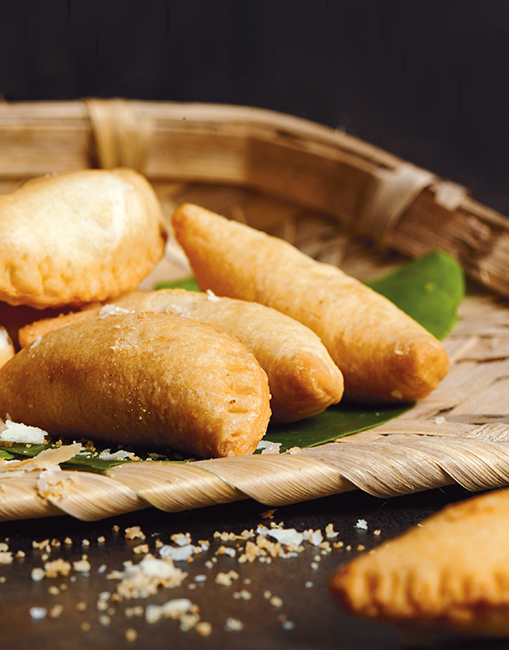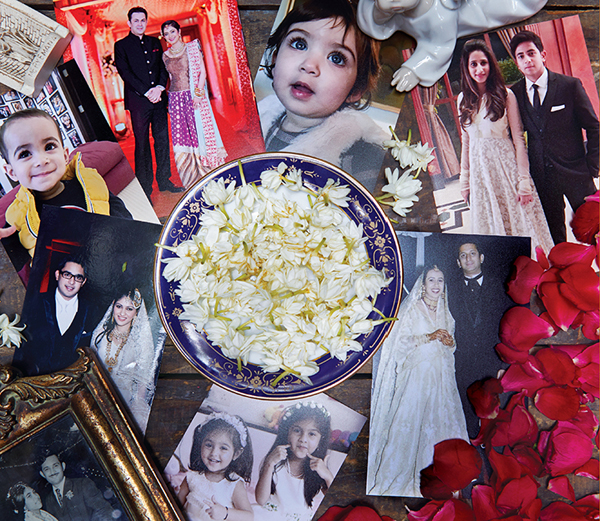

PURAN POORI
Many communities make a version of puran poli, but this is an extremely unusual recipe, which I learnt from our aunt, Zehra Phuppu, in my first cooking lesson. It is a bit indulgent in our health-conscious age but I recommend you try it at least once – it is absolutely delicious and you will not regret it.
INGREDIENTS
3 kg sugar
2 kg ghee
1 kg Bengal gram
1 kg semolina
½ kg almonds, blanched and ground to a fine paste
3 cardamoms, peeled and powdered
A few strands of saffron
Water as needed
METHOD
Boil the Bengal gram until it is very soft. Strain it, let it cool just a bit and then mash it to a fine paste.
In a large, heavy-bottomed pan, put half the ghee to heat. Add the mashed dal and sauté on a low flame until brown. Very carefully, drain off the remaining ghee into a bowl and set aside.
Continue cooking the paste on a low flame and add the ground almonds, saffron and sugar. Mix well to combine and let it all cook to a fine consistency. Take the pan off the flame and set aside.
Mix the semolina, remaining ghee and as much as water as you need to make a soft, pliable dough. Roll out thin rotis and cook each on both sides on a tawa.
Grease a large baking dish or lagan and arrange a layer of the rotis on the bottom. Cover with a layer of the dhal mixture and pour ghee over it.
Repeat until you have used up all the rotis, mixture and ghee. The last pour of ghee needs to be more generous than the rest.
Cover with foil and bake in a hot oven. If you are using a lagan, you can cook this over coals. Do place some hot coals on top of the dish as well. In 30 minutes, the puran poori should be golden brown in colour.
Leave it aside to cool, cut into thin slices and serve.
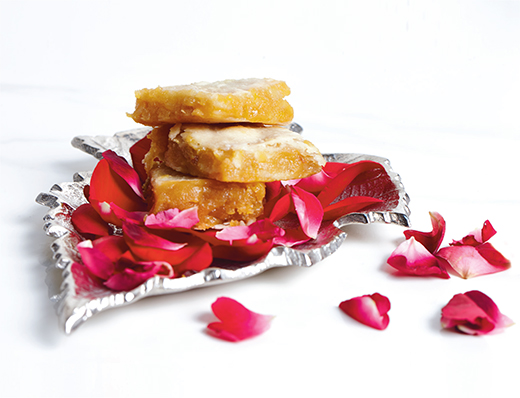
PHIRNEE
In our early years in Delhi, after I’d mastered the biryani and could cook a spread for dinner, we still ordered in dessert. Peter liked to serve phirnee, which he would get from the Old City. It was delicious, of course, and I would often ask him if it was expensive but he always said no. And then one day, the man delivered the phirnee when I was home alone so I asked for the bill. It turned out to be ₹11 per bowl, which was a lot in those days. I decided right then and there to learn how to make phirnee.
As it happened, I’d seen a recipe for it in a magazine, but now I’ve forgotten which one it was. The next time Peter was out of town, I tried my hand at making phirnee and my father, who was visiting us at the time, said it was very good. He thought it was even better than what we ordered from the Old City, which boosted my confidence.
Before our next dinner party, I told Peter not to order dessert. I made the phirnee and served it in earthen bowls, arranged very prettily on a big platter decorated with rose petals. It won me many compliments and the recipe I found by chance in a magazine is now one of my favourites. It makes enough for 15 servings.
INGREDIENTS
2 litres milk
½ kg sugar
¼ kg fresh cream
¼ kg rice
10 tablespoons almonds, finely chopped
10 tablespoons pistachios, finely chopped
2 teaspoons almond essence
Varaq for garnish
METHOD
Wash and soak rice for an hour. Then grind to a very smooth paste and keep aside.
In a large, thick-bottomed pan, put the milk to boil. Once it comes to a boil, take the pan off the flame and mix in the ground rice. Return the pan to the stove and allow the milk and rice mixture to thicken, stirring continuously to ensure it stays very smooth.
Mix in sugar and fresh cream as the mixture thickens. Continue stirring and cooking for 10 more minutes. Just a minute before it is done, mix in the almond essence.
Take the pan off the flame and spoon the phirnee into bowls. Cover each with a piece of varaq and garnish with almonds and pistachios.
Store these in the refrigerator or serve at room temperature.
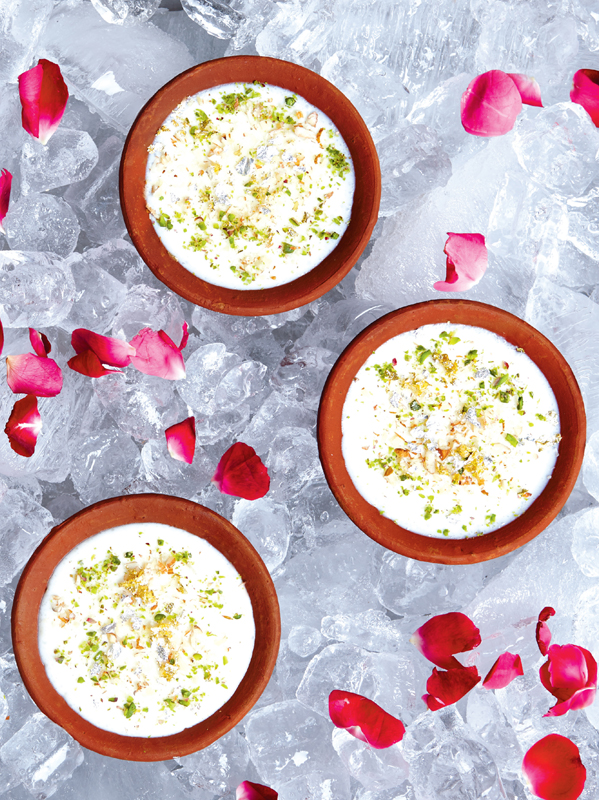
SHEER KHORMA
INGREDIENTS
3 litres milk
300 gm vermicelli
250 gm sugar
75 gm pistachios, soaked for 3 hours, chopped
75 gm almonds, blanched and finely chopped
50 gm raisins, finely chopped
1 tin condensed milk
15 dry dates, deseeded and sliced lengthwise
9 tablespoons ghee
A few strands of saffron
METHOD
Melt ghee, add vermicelli in a large pan. Immediately lower the flame and fry until the vermicelli turns a light golden brown. Add milk and bring to a slow boil. Then, add condensed milk, dates and raisins. Allow the mixture to thicken on a low flame.
Serve by pouring into a large, deep bowl and decorate with pistachios and almonds.
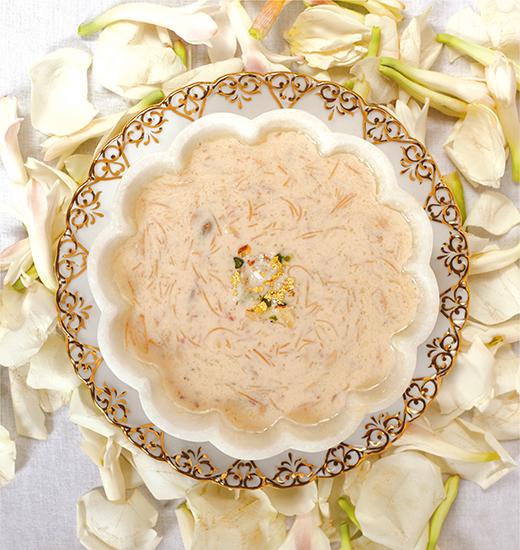
Sheer Khorma
KHUBANI KA MEETHA
This is our family recipe for the quintessentially Hyderabadi dessert. Use good-quality apricots that are sweet enough for you to leave the sugar out altogether. I prefer that natural sweetness.
INGREDIENTS
1 kg apricots
75 gm almonds, blanched and finely chopped
½ teaspoon cochineal (red food colouring)
A few drops of vanilla essence
4 tablespoons sugar
METHOD
Soak apricots overnight in enough water to cover them. Deseed them the next morning. Break the seeds and remove the almonds that are tucked inside. Soak these in hot water and peel. Set aside to use as a garnish later.
Boil the apricots in enough water to cover them. Add more water later, if required. The apricots need to break down into a thick paste. Taste for sweetness and add sugar accordingly. Do not add more than four tablespoons, though. Mix in cochineal and vanilla essence and cook for a few minutes to let the sugar melt.
Take the pan off the flame and allow the apricot mixture to cool. You can either blend this to create a smooth, thick paste or keep the consistency chunky. Pour into a bowl and decorate with the almonds you had set aside earlier. Serve with fresh cream or a custard.
DOUBLE KA MEETHA
This dish is named so because bread is known as double roti in Hyderabad. It is also called Shahi Tukra.
INGREDIENTS
1 loaf sliced bread
1 brick ice cream
50 gm cashew nuts, crumbled
50 gm raisins
50 gm chironjee
5 cups milk
5 cups water
5 cups sugar
1 litre oil
A few cardamoms, roughly powdered
METHOD
Cut the bread slices into halves and set aside. Heat water and dissolve the sugar in it. Then, add milk and cardamom powder. Pour this into the serving dish.
Heat oil and fry a few bread slices at a time until golden brown. Remove onto a plate lined with absorbent paper, and set aside. When all the slices are fried, place them in the milk mixture in the serving dish. Allow them to soak up all the liquid.
Fry the chironjee, then the cashew nuts and, finally, the raisins. in the same oil Set aside. Strain the oil and set aside too. Just before you are ready to serve, whip the ice-cream (or cream) to soften it and cover the top of the Double ka Meetha with it. Sprinkle the fried toppings on it and dribble a tablespoon of the oil over.
BADAAM KE PAAN
INGREDIENTS
1 ½ cup almonds, blanched and
ground to a fine paste
1 cup water
1 cup cloves
¾ cup sugar
1-2 teaspoons green food colouring
1 teaspoon milk
Varaq to garnish
METHOD
In a large pan, mix sugar and water and cook into a thick syrup. Add milk and the almond paste and keep stirring until the mixture leaves the sides of the pan. Take off the flame and mix in as much green food colouring as you like; ideally, it should be the colour of a paan leaf. Form a soft dough using your fingers. Divide this dough into small portions. Roll out each portion and fold into the shape of a paan. Secure with a clove.
Cover with varaq and serve on a silver platter.
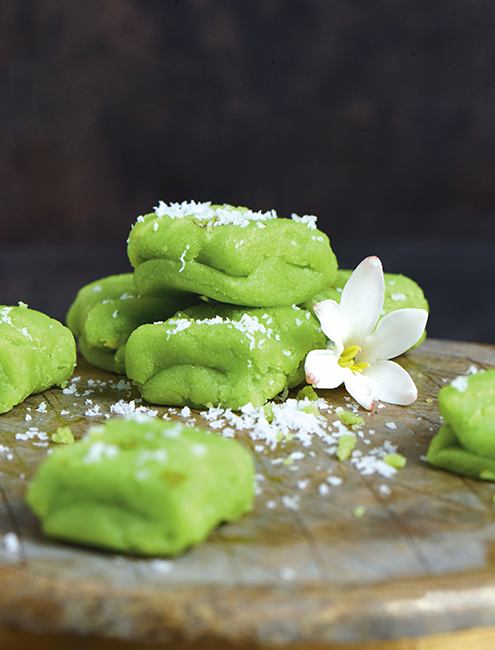
Badaam ke Paan
BADAAM KI JALI
INGREDIENTS
450 gm sugar
2 cups almonds
1 cup water
6 tablespoons milk
½ tablespoon cardamom powder
METHOD
Soak almonds overnight in water. The next morning, blanch them and grind to a fine paste using milk. Boil the water and 225 gram sugar to make a syrup. Flavour with cardamom powder.
Mix the almond paste into the sugar syrup. Cook over a medium flame until the mixture leaves the sides of the pan and forms a ball. Take the pan off the stove and let the paste cool slightly. Roll into lime-sized balls. Grind the rest of the sugar to a very fine powder. Dust a board with this. On this board, roll half the balls into flat 2" rounds. Place these on a greased baking tray and moisten the sides by dipping your finger into a bowl of water and tracing the sides.
Cut out pieces of varaq and cover each round with one. Roll out the rest of the almond balls into 2" rounds. Use a cutter or mould to create a design on these. Lay each one on top of the varaq-covered rounds on the baking tray. Bake in a preheated oven at 190° for 20 minutes. The rounds should not brown but they should dry out. Cool and store. To serve, place on a pretty platter and scatter with rose petals.
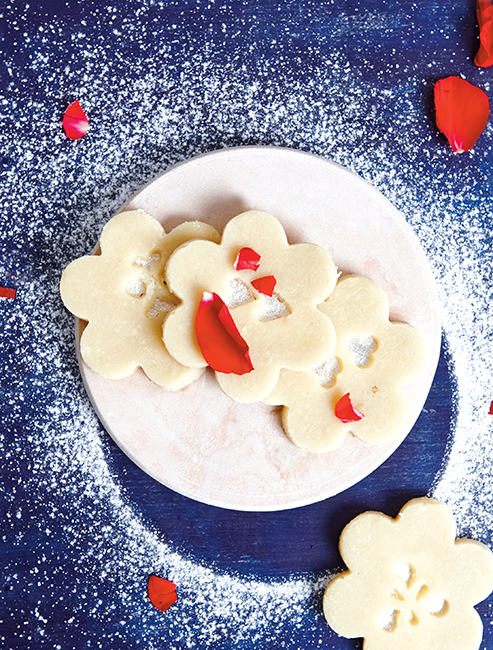
Badaam Ki Jali
BADAAM KA HALWA
INGREDIENTS
200 gm almonds, ground
200 gm sugar
150 ml fresh cream
75 gm unsalted butter
To garnish
10 almonds, soaked and peeled
10 pistachios, shelled and finely sliced
METHOD
Melt the butter in a thick-bottomed pan. Just as it begins to froth, lower the heat and add ground almonds, sugar and cream. Cook on a low heat for 10 to 15 minutes.
When the mixture darkens in colour, take off the heat and pour into a flat, greased dish. Smooth the top with a spatula. Garnish with the peeled almonds and sliced pistachios.
Slice into squares and serve. You can substitute the sugar with 5 tablespoons of Diabliss, if you would prefer that. The taste does not change at all.
DAHI KE LAUZ
‘Lauz’ is the Hyderabadi word for a peda or a barfi.
INGREDIENTS
1 litre milk
1 cup yogurt
1 cup sugar
Powdered cardamoms to garnish
A length of clean, fine muslin
METHOD
Tie the yogurt in the muslin cloth and let all liquid drain off. In a thick-bottomed pan, boil milk until it reduces to half. Take off the stove and let cool. Mix in the drained yogurt and sugar, and pass the mixture through a strainer. The consistency needs to be very smooth. Spoon the smooth milk and yogurt mix into a baking dish, and place it in a water bath.
Place this water bath over a low flame and cook until the mixture sets. Do not cover the water bath, and make sure that the water does not dry up. So, keep hot water at hand to refill, if needed. When the milk and yogurt mixture sets, take the water bath off the flame. Cut into squares and garnish with powdered cardamom; it can be stored in an airtight container in a cool place. Serve in a flat silver dish.
ANDE KE LAUZ
INGREDIENTS
½ kg sugar
½ kg ghee
½ kg khoya
12 eggs
4 cardamoms, powdered
A few raisins, shredded
A few almonds, shredded
A few strands of saffron, melted in a little water
A little grated nutmeg
METHOD
Beat eggs, sugar, khoya and ghee together. Mix in shredded almond and raisins. Heat ghee in a pan and cook this mixture over a low flame, stirring all the time to prevent burning or curdling. When the mixture starts leaving the sides of the pan, take it off the flame and add melted saffron, nutmeg and cardamom powder.
Pour into a greased dish and bake in an oven at 150° Celsius until the top is light brown.
Let it cool, cut into diamond-shaped pieces and serve.
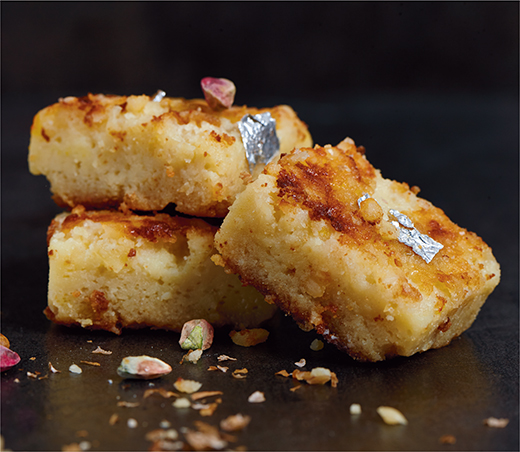
Ande Ke Lauz
NOWRIS
This is a Hyderabadi dessert, which is like a Goan one called Neori. I love this sweet very much, though I don’t make it very often.
INGREDIENTS
For the pastry
½ kg plain flour, or maida
1 cup ghee
A pinch of salt
Water to knead the dough
For the filling
½ kg semolina
½ kg sugar
¼ cup ghee
1 coconut, grated
3 tablespoons cashew nuts
½ teaspoon cardamom powder
Cornflour for dusting
METHOD
TO MAKE THE PASTRY
Mix the ghee and flour, using your fingers, until the mixture resembles fine breadcrumbs.
Dissolve the salt in the water. Use this to make a pliable dough. Cover and set aside in a cool place.
TO MAKE THE FILLING
Heat the ghee in a pan until it starts bubbling. Add in the semolina and fry well, stirring from time to time so that it is evenly and lightly browned.
Add sugar and turn the heat down. Stir continuously until the mixture dries up. Add grated coconut and cook for a while more.
Add cashew nuts, raisins and cardamom powder. Mix well to combine.
Take the pan off the flame and let the filling cool.
TO MAKE THE PATTIES
Apply ghee on nine chapattis and dust with cornflour. Layer them, with the greased side facing up. The last layer needs to be an ungreased chapatti.
Roll out so that the layers stick to one another. Cut into rounds.
Put a spoonful of the semolina mixture in each round. Wet the edges and fold into half. With the end of a fork, scallop the edges.
Deep fry until light browned, store in an airtight jar. It will keep for at least a month.
You can skip making the nine-layer dough, if you like. Just fill each chapatti separately and fry it.
